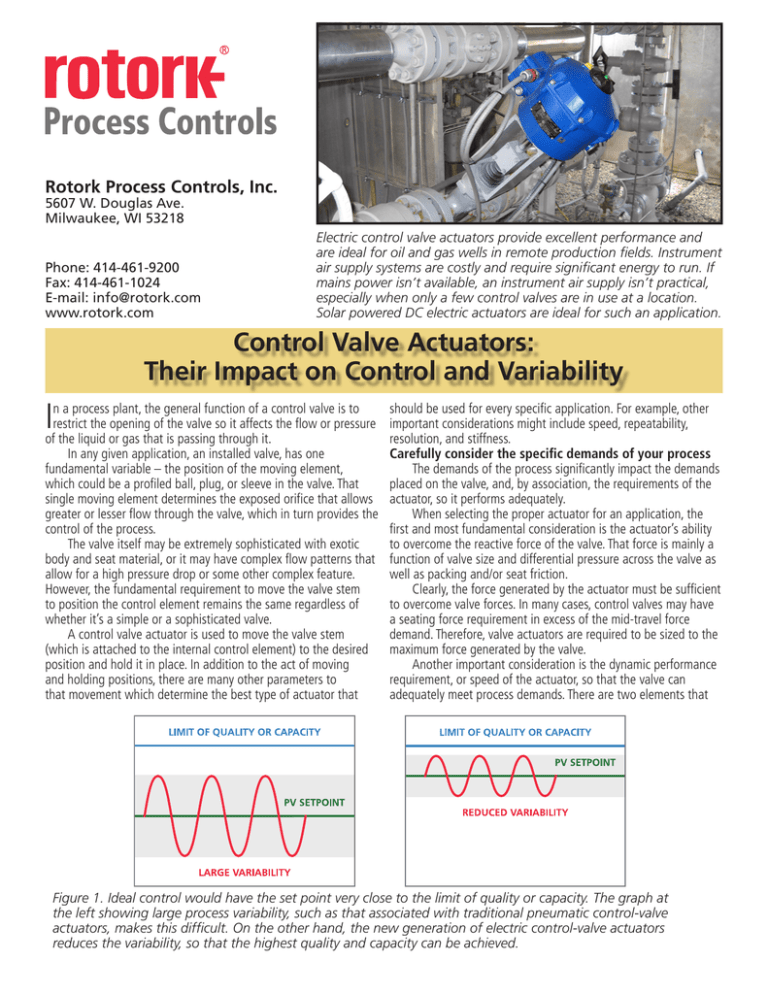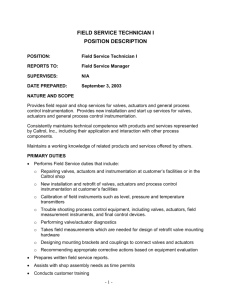
Rotork Process Controls, Inc.
5607 W. Douglas Ave.
Milwaukee, WI 53218
Phone: 414-461-9200
Fax: 414-461-1024
E-mail: info@rotork.com
www.rotork.com
Electric control valve actuators provide excellent performance and
are ideal for oil and gas wells in remote production fields. Instrument
air supply systems are costly and require significant energy to run. If
mains power isn’t available, an instrument air supply isn’t practical,
especially when only a few control valves are in use at a location.
Solar powered DC electric actuators are ideal for such an application.
Control Valve Actuators:
Their Impact on Control and Variability
I
n a process plant, the general function of a control valve is to
restrict the opening of the valve so it affects the flow or pressure
of the liquid or gas that is passing through it.
In any given application, an installed valve, has one
fundamental variable – the position of the moving element,
which could be a profiled ball, plug, or sleeve in the valve. That
single moving element determines the exposed orifice that allows
greater or lesser flow through the valve, which in turn provides the
control of the process.
The valve itself may be extremely sophisticated with exotic
body and seat material, or it may have complex flow patterns that
allow for a high pressure drop or some other complex feature.
However, the fundamental requirement to move the valve stem
to position the control element remains the same regardless of
whether it’s a simple or a sophisticated valve.
A control valve actuator is used to move the valve stem
(which is attached to the internal control element) to the desired
position and hold it in place. In addition to the act of moving
and holding positions, there are many other parameters to
that movement which determine the best type of actuator that
should be used for every specific application. For example, other
important considerations might include speed, repeatability,
resolution, and stiffness.
Carefully consider the specific demands of your process
The demands of the process significantly impact the demands
placed on the valve, and, by association, the requirements of the
actuator, so it performs adequately.
When selecting the proper actuator for an application, the
first and most fundamental consideration is the actuator’s ability
to overcome the reactive force of the valve. That force is mainly a
function of valve size and differential pressure across the valve as
well as packing and/or seat friction.
Clearly, the force generated by the actuator must be sufficient
to overcome valve forces. In many cases, control valves may have
a seating force requirement in excess of the mid-travel force
demand. Therefore, valve actuators are required to be sized to the
maximum force generated by the valve.
Another important consideration is the dynamic performance
requirement, or speed of the actuator, so that the valve can
adequately meet process demands. There are two elements that
Figure 1. Ideal control would have the set point very close to the limit of quality or capacity. The graph at
the left showing large process variability, such as that associated with traditional pneumatic control-valve
actuators, makes this difficult. On the other hand, the new generation of electric control-valve actuators
reduces the variability, so that the highest quality and capacity can be achieved.
should be considered when evaluating actuator speed. The first is the
reaction time to initiate movement after a demand signal change,
and the other is the speed of operation once motion is initiated.
It’s important to note that electronically controlled electric
actuators react almost instantaneously to a demand change
when required. Pneumatic actuators, on the other hand, need to
physically build up sufficient pressure in the piston or diaphragm
to initiate movement. That generates a delay or dead time, which
can negatively impact the process.
Once motion is initiated, an electric actuator is restricted by
the maximum speed of its motor, whereas a pneumatic actuator
can move as quickly as the air can drive the piston or diaphragm.
For smaller incremental changes in demand, the electric actuator’s
reaction time is significantly faster than an equivalent pneumatic
actuator with a nominal dead time. Conversely, for large swings in
demand signal, pneumatic actuators have the advantage of faster
stroking speeds over longer distances.
Other important considerations in actuator selection are
resolution, repeatability, and precision.
Resolution is defined as the minimum change in demand
signal that results in a change in output when moving in the same
direction. This is an important measurement as it determines how
finely the control valve can be positioned to affect the process.
Repeatability is the closeness of agreement of a number
of consecutive measurements of the output for the same value
of inputs when approaching from the same direction. The
combination of resolution and repeatability impacts the precision
in which the control valve can be positioned.
The benefit of precise control on process variability is well
documented: the greater the precision, the greater the control that
can be exerted over the process. That is, a greater precision can
significantly reduce process variability, which can have a positive
impact on the quality of the product produced as well as the
production capacity the plant can achieve. These benefits accrue
from using a more precisely controlled valve.
Actuators that are able to deliver high repeatability and
high resolution are therefore more valuable to the process than
actuators that do not have this capability.
Figure 2. Block diagram of control circuit.
-2-
New electric actuators can significantly improve
traditional performance
While some pneumatic valve positioners catalog resolutions
on the order of 0.1% that claim can be misleading. That is, once
those positioners are coupled to pneumatic valve actuators,
feedback linkage connections and other external factors diminish
the resolution. Certain new electric actuators, however, combine
the position feedback as an integral component of the actuator
and are thus able to achieve genuine performance figures in the
region of 0.1% repeatability and resolution.
It should also be noted that the nature and application of
control valves often conspire to diminish the dynamic performance
of the valve. Valve packing friction in globe valves or seat friction
in ball valves can cause problems when trying to dynamically
position a valve to a new set point in a minimum time.
Because air is a compressible medium, it has difficulty in
providing precise control, especially when valves are “sticky.”
The static friction in the valve requires excess air to be introduced
to the actuator in order to break the valve from the seat or the
packing friction. Once the valve has broken free, the dynamic
friction being less causes the excess air to overshoot the desired
set point causing an oscillation.
The oscillation adversely affects process variability. Similarly,
pneumatic actuators when mounted on globe valves tend to
exhibit resilience under the action of a pressure spike or surge in
the pipeline media.
Electric actuators, on the other hand, with their mechanical
drive train are inherently stiffer and are able to hold the set point
better. That means that under surge or cavitation conditions, the
valve will hold its position and maintain the process set point.
Technological advances: Times Have Changed
Currently, the industry standard for control valve actuators
is the spring diaphragm unit with a digital positioner. Because
of its simplicity, the spring diaphragm actuator is found in
virtually every type of application and is simple, robust, and easily
provides a fail open/close capability. Digital positioners have
become sophisticated enough to overcome, to a certain degree,
the problems of a stick slip and overshoot, but can be extremely
demanding in terms of calibration, set up, and maintenance.
Until recently, the control of electric actuators was inferior
to spring-diaphragm control valve actuators, either the electric
drive was too slow to provide the response required, or the motor
and drive train inertia of high-speed actuators precluded precise
positioning.
New control technology has overcome these problems by
sensing not just the output position of the actuator but also the
motor position and speed.
The block diagram of the control circuit (see Figure 2) shows
that the output of the actuator is fed back and compared to
the demand position signal. The resulting error signal is fed into
the motor speed profile. The actual speed of the motor is then
compared to the demand speed and that error signal in turn is fed
into the motor controller.
The accuracy of the sensors coupled with the control logic
circuit can result in the elimination of overshoot normally
experienced on “sticky valves.” By eliminating overshoot, process
variability is significantly reduced and many significant benefits
result.
Also, new electric control valve actuators put to rest a
common perception that electric actuators are susceptible to
mechanical wear when used for constant modulation. With
careful gear design and material selection the drive train of the
new generation of control valves actuators can achieve many
millions of cycles, even under the full-rated load of the actuator. In
fact, some tests have shown that over 200 million cycles can be
achieved even at elevated loads.
Another obstacle when comparing functionality of
conventional spring diaphragm actuators with electric actuators is
A wealth of applications
Rotork CVA all-electric control-valve actuators are
ideal for a wide range of applications that demand
precise operation, reliability, and freedom from the
encumbrances associated with instrument air.
Below are just a few examples of applications
where CVA actuators are currently being used.
• Fuel terminals
• Power stations
• Chemical plants
• Offshore oil and gas production platforms
• Oil and gas wells
• Manufacturing facilities
• Water and wastewater treatment plants
• HVAC plants
There are a lot more.
A fertilizer plant, which produces a full line of
nitrogen fertilizers and industrial products, purchased
five CVA electric actuators so they didn’t have
to depend on instrument air. By using all-electric
control-valve actuators, it means that moisture and
particulate contamination from instrument air is no
longer a worry. In the past, they had experienced
problems with check valves and leakage with air
receivers. Since the installation of the CVA actuators
in 2009, the all-electric actuators have performed
extremely well, and unlike pneumatic actuators,
there is no drift in the actuator calibration, so
accurate control is ensured without continuous
maintenance intervention.
Rotork CVA all-electric control valve actuators (available
in rotary and linear actions) are pictured above.
-3-
the ability to fail to an open/close position. Recent developments
in electric actuators have utilized stored energy in super
capacitors. The electrical energy stored in the capacitor can
generate a high power density enabling the electric motor and
drive train to position the actuator not only to an open or close
position but to any selected intermediate position. This versatility
can deliver additional benefits to some processes where complete
shut down of the process could be a problem.
Summary
The technological developments incorporated in the new
generation of electric actuators offer many significant functional
and performance advantages over conventional control valve
actuators.
Electric actuators can deliver improved process variability
due to the precision of their performance. Reaction to changes in
set point and maintenance of the set point, even when there are
upsets in the process, can significantly reduce process variability.
In addition, the new generation electric actuators are easily
installed and integrated into Bus systems such as Hart, Foundation
Fieldbus, and Profibus.
Another significant benefit is that electric control valve
actuators eliminate the sometimes troublesome instrument air
supply requirement.
Also, the new electric control valve actuators have an integral
thrust or torque sensor (depending on whether the actuator
is a linear or quarter-turn output). The measurement of thrust
and torque is invaluable when combined with simultaneous
reading of position. These readings are retained in the control
valve actuator’s built-in data logger and can be downloaded for
detailed analysis.
Because thrust measurement or torque measurement is a
direct reading – not one that is derived from the pressure over a
piston or diaphragm area – the measurement is immediate and
accurate. That means the changes in the characteristic of the valve
can be monitored to predict when maintenance related to packing
or seats is required.
Finally, the human machine interfaces (HMI) that are available
for use with these new electric control valve actuators provide
easy access to important performance and analytical data. Simple
and user-friendly HMI tools such as PDAs and laptop computers
can communicate wirelessly via BlueTooth™ to the actuator.
All of the settings, configurations, calibration, data logging,
and analysis tools are available to facilitate easy installation of the
control valve actuator and to provide the information appropriate
to the modern plant’s asset management systems.
CVAs help water plant meet a
strict environmental mandate
To meet a provincial environmental mandate, a
Canadian water plant needed to upgrade the way
it removes chlorine from residuals resulting from
its treatment process.
To accomplish the upgrade, the plant selected
a valve that would best suit their process and
matched it to the CVA precision electric control
valve actuator. Before the CVA was introduced, a
precision electric actuator with manual override
and fail-to-position capability was not available.
Testing was done using three actuators
mounted to valves installed at a pilot project.
One is a replacement of a pump sitting beside
an existing unit and the other two are mounted
in the same split range configuration that will be
used at a sister plant to handle flows that range
from 0.0138 L/min to 30.6523 L/min. The smaller
valve will have a Cv of 0.1, and the larger valve will
have a Cv of 2.5. The actuators are programmed
to adjust accordingly based on flow meter data
collected immediately prior to the process seeing
the control valves.
The testing proved the effectiveness of the
CVA on the precision Fisher valves. Sixteen more
CVAs are being installed at the sister plant.
About the author:
Chris Warnett has over 32 years experience in the valve and actuator industry.
He is a registered mechanical engineer, has worked in actuator design and
application in both Europe and the United States, and is currently International
Sales and Marketing Director at Rotork Process Controls.
NOTE: You can obtain a document that will help you
calculate the cost savings of electric vs. air power by contacting:
Chris Warnett, International Sales and Marketing Director
Rotork Process Controls
5607 W. Douglas Ave. • Milwaukee, WI 53218
Phone: 414-461-9200 • Fax: 414-461-1024
E-mail: chris.warnett @rotork.com • Website: www.rotork.com
© Copyright 2010 by Rotork Process Controls, Inc. All rights reserved.




